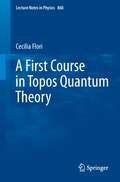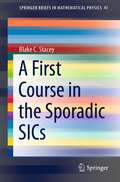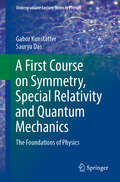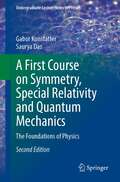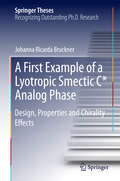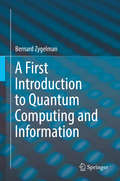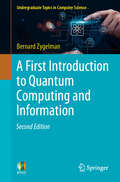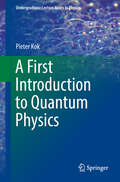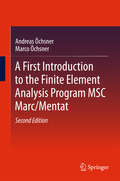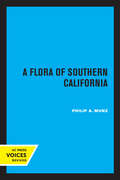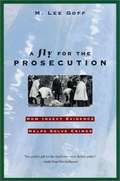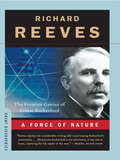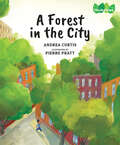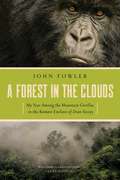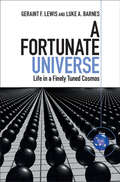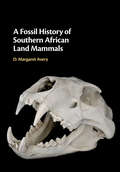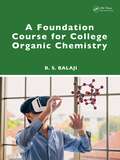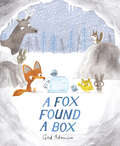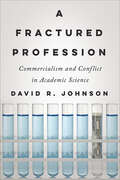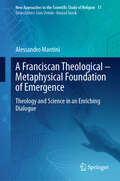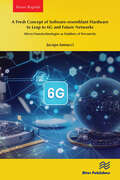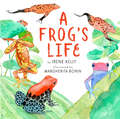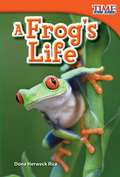- Table View
- List View
A First Course in Topos Quantum Theory (Lecture Notes in Physics #868)
by Cecilia FloriIn the last five decades various attempts to formulate theories of quantum gravity have been made, but none has fully succeeded in becoming the quantum theory of gravity. One possible explanation for this failure might be the unresolved fundamental issues in quantum theory as it stands now. Indeed, most approaches to quantum gravity adopt standard quantum theory as their starting point, with the hope that the theory's unresolved issues will get solved along the way. However, these fundamental issues may need to be solved before attempting to define a quantum theory of gravity. The present text adopts this point of view, addressing the following basic questions: What are the main conceptual issues in quantum theory? How can these issues be solved within a new theoretical framework of quantum theory? A possible way to overcome critical issues in present-day quantum physics - such as a priori assumptions about space and time that are not compatible with a theory of quantum gravity, and the impossibility of talking about systems without reference to an external observer - is through a reformulation of quantum theory in terms of a different mathematical framework called topos theory. This course-tested primer sets out to explain to graduate students and newcomers to the field alike, the reasons for choosing topos theory to resolve the above-mentioned issues and how it brings quantum physics back to looking more like a "neo-realist" classical physics theory again.
A First Course in the Sporadic SICs (SpringerBriefs in Mathematical Physics #41)
by Blake C. StaceyThis book focuses on the Symmetric Informationally Complete quantum measurements (SICs) in dimensions 2 and 3, along with one set of SICs in dimension 8. These objects stand out in ways that have earned them the moniker of "sporadic SICs". By some standards, they are more approachable than the other known SICs, while by others they are simply atypical. The author forays into quantum information theory using them as examples, and the author explores their connections with other exceptional objects like the Leech lattice and integral octonions. The sporadic SICs take readers from the classification of finite simple groups to Bell's theorem and the discovery that "hidden variables" cannot explain away quantum uncertainty.While no one department teaches every subject to which the sporadic SICs pertain, the topic is approachable without too much background knowledge. The book includes exercises suitable for an elective at the graduate or advanced undergraduate level.
A First Course on Symmetry, Special Relativity and Quantum Mechanics: The Foundations of Physics (Undergraduate Lecture Notes in Physics)
by Gabor Kunstatter Saurya DasThis book provides an in-depth and accessible description of special relativity and quantum mechanics which together form the foundation of 21st century physics. A novel aspect is that symmetry is given its rightful prominence as an integral part of this foundation. The book offers not only a conceptual understanding of symmetry, but also the mathematical tools necessary for quantitative analysis. As such, it provides a valuable precursor to more focused, advanced books on special relativity or quantum mechanics.Students are introduced to several topics not typically covered until much later in their education.These include space-time diagrams, the action principle, a proof of Noether's theorem, Lorentz vectors and tensors, symmetry breaking and general relativity. The book also provides extensive descriptions on topics of current general interest such as gravitational waves, cosmology, Bell's theorem, entanglement and quantum computing.Throughout the text, every opportunity is taken to emphasize the intimate connection between physics, symmetry and mathematics.The style remains light despite the rigorous and intensive content. The book is intended as a stand-alone or supplementary physics text for a one or two semester course for students who have completed an introductory calculus course and a first-year physics course that includes Newtonian mechanics and some electrostatics. Basic knowledge of linear algebra is useful but not essential, as all requisite mathematical background is provided either in the body of the text or in the Appendices. Interspersed through the text are well over a hundred worked examples and unsolved exercises for the student.
A First Course on Symmetry, Special Relativity and Quantum Mechanics: The Foundations of Physics (Undergraduate Lecture Notes in Physics)
by Gabor Kunstatter Saurya DasThis book provides an in-depth and accessible description of special relativity and quantum mechanics which together form the foundation of 21st century physics. A novel aspect is that symmetry is given its rightful prominence as an integral part of this foundation. The book offers not only a conceptual understanding of symmetry, but also the mathematical tools necessary for quantitative analysis. As such, it provides a valuable precursor to more focused, advanced books on special relativity or quantum mechanics.Students are introduced to several topics not typically covered until much later in their education.These include space-time diagrams, the action principle, a proof of Noether's theorem, Lorentz vectors and tensors, symmetry breaking and general relativity. The book also provides extensive descriptions on topics of current general interest such as gravitational waves, cosmology, Bell's theorem, entanglement and quantum computing.Throughout the text, every opportunity is taken to emphasize the intimate connection between physics, symmetry and mathematics.The style remains light despite the rigorous and intensive content. The book is intended as a stand-alone or supplementary physics text for a one or two semester course for students who have completed an introductory calculus course and a first-year physics course that includes Newtonian mechanics and some electrostatics. Basic knowledge of linear algebra is useful but not essential, as all requisite mathematical background is provided either in the body of the text or in the Appendices. Interspersed through the text are well over a hundred worked examples and unsolved exercises for the student.
A First Example of a Lyotropic Smectic C* Analog Phase: Design, Properties and Chirality Effects (Springer Theses)
by Johanna Ricarda BrucknerIn this thesis Johanna Bruckner reports the discovery of the lyotropic counterpart of the thermotropic SmC* phase, which has become famous as the only spontaneously polarized, ferroelectric fluid in nature. By means of polarizing optical microscopy, X-ray diffraction and electro-optic experiments she firmly establishes aspects of the structure of the novel lyotropic liquid crystalline phase and elucidates its fascinating properties, among them a pronounced polar electro-optic effect, analogous to the ferroelectric switching of its thermotropic counterpart. The helical ground state of the mesophase raises the fundamental question of how chiral interactions are "communicated" across layers of more or less disordered and achiral solvent molecules which are located between adjacent bi-layers of the chiral amphiphile molecules. This thesis bridges an important gap between thermotropic and lyotropic liquid crystals and pioneers a new field of liquid crystal research.
A First Introduction to Quantum Computing and Information
by Bernard ZygelmanThis book addresses and introduces new developments in the field of Quantum Information and Computing (QIC) for a primary audience of undergraduate students. Developments over the past few decades have spurred the need for QIC courseware at major research institutions. This book broadens the exposure of QIC science to the undergraduate market. The subject matter is introduced in such a way so that it is accessible to students with only a first-year calculus background. Greater accessibility allows a broader range of academic offerings. Courses, based on this book, could be offered in the Physics, Engineering, Math and Computer Science departments. This textbook incorporates Mathematica-based examples into the book. In this way students are allowed a hands-on experience in which difficult abstract concepts are actualized by simulations. The students can ‘turn knobs" in parameter space and explore how the system under study responds. The incorporation of symbolic manipulation software into course-ware allows a more holistic approach to the teaching of difficult concepts. Mathematica software is used here because it is easy to use and allows a fast learning curve for students who have limited experience with scientific programming.
A First Introduction to Quantum Computing and Information (Undergraduate Topics in Computer Science)
by Bernard ZygelmanThis textbook addresses and introduces new developments in the field of quantum information and computing (QIC) for a primary audience of undergraduate students. Developments over the past few decades have spurred the need for QIC courseware at major research institutions. To address this, the present 2nd edition of a highly accessible textbook/reference broadens the exposure of QIC science for the undergraduate market. The subject matter is introduced in such a way so that it is accessible to students with only a first-year calculus background. Greater accessibility allows a broader range of academic offerings. Topics and features: Introduces beginning undergraduate students to quantum theory and developments in QIC, without exposure to upper-level physics and mathematics Contains a new chapter on Adiabatic Quantum Computing Integrates Mathematica-based software examples and projects, which offers a “hands-on" experience and facilitates navigation of difficult abstract concepts Offers helpful links to additional exercises, problems, and solution manuals Facilitates a more holistic approach to the teaching of difficult concepts, incorporating symbolic manipulation software Provides new material on Quantum Error Correction Allows a broad-range of course offerings spanning physics, engineering, math and computer science This unique introductory textbook can serve courses offered in university physics, engineering, math, and definitely computer science departments. Use of Mathematica software allows a fast learning curve for students who have limited experience with scientific programming.
A First Introduction to Quantum Physics (Undergraduate Lecture Notes in Physics)
by Pieter KokIn this undergraduate textbook, the author develops the quantum theory from first principles based on very simple experiments: a photon travelling through beam splitters to detectors, an electron moving through a Stern-Gerlach machine, and an atom emitting radiation. From the physical description of these experiments follows a natural mathematical description in terms of matrices and complex numbers. The first part of the book examines how experimental facts force us to let go of some deeply held preconceptions and develops this idea into a mathematical description of states, probabilities, observables, and time evolution using physical applications. The second part of the book explores more advanced topics, including the concept of entanglement, the process of decoherence, and extension of the quantum theory to the situation of a particle in a one-dimensional box. Here, the text makes contact with more traditional treatments of quantum mechanics. The remaining chapters delve deeply into the idea of uncertainty relations and explore what the quantum theory says about the nature of reality. The book is an ideal and accessible introduction to quantum physics, with modern examples and helpful end-of-chapter exercises.
A First Introduction to the Finite Element Analysis Program MSC Marc/Mentat
by Andreas Öchsner Marco ÖchsnerThis book offers a brief introduction to the general-purpose finite element program MSC Marc, focusing on providing simple examples, often single-element problems, which can easily be related to the theory that is discussed in finite element lectures. As such, it is an ideal companion book to classical introductory courses on the finite element method. MSC Marc is a specialized program for non-linear problems (implicit solver), which is distributed by the MSC Software Corporation and commonly used in academia and industry. The documentation of all finite element programs now includes a variety of step-by-step examples of differing complexity, and all software companies offer professional workshops on different topics. Since the first edition of the book, there have been several new releases of Marc/Mentat and numerous changes. This new edition incorporates the latest Marc/Mentat software developments and new examples.
A Flora of Southern California
by Philip A. MunzThis title is part of UC Press's Voices Revived program, which commemorates University of California Press’s mission to seek out and cultivate the brightest minds and give them voice, reach, and impact. Drawing on a backlist dating to 1893, Voices Revived makes high-quality, peer-reviewed scholarship accessible once again using print-on-demand technology. This title was originally published in 1974.
A Fly For The Prosecution: How Insect Evidence Helps Solve Crimes
by M. Lee GoffThe forensic entomologist turns a dispassionate, analytic eye on scenes from which most people would recoil--human corpses in various stages of decay, usually the remains of people who have met a premature end through accident or mayhem. To Lee Goff and his fellow forensic entomologists, each body recovered at a crime scene is an ecosystem, a unique microenvironment colonized in succession by a diverse array of flies, beetles, mites, spiders, and other arthropods: some using the body to provision their young, some feeding directly on the tissues and by-products of decay, and still others preying on the scavengers. Using actual cases on which he has consulted, Goff shows how knowledge of these insects and their habits allows forensic entomologists to furnish investigators with crucial evidence about crimes. Even when a body has been reduced to a skeleton, insect evidence can often provide the only available estimate of the postmortem interval, or time elapsed since death, as well as clues to whether the body has been moved from the original crime scene, and whether drugs have contributed to the death. An experienced forensic investigator who regularly advises law enforcement agencies in the United States and abroad, Goff is uniquely qualified to tell the fascinating if unsettling story of the development and practice of forensic entomology.
A Focus On Life Science Reading And Note Taking Guide, Level
by Prentice-Hall StaffFocus on Life Science Reading and Note Taking Guide Level B California Edition
A Force of Nature: The Frontier Genius of Ernest Rutherford (Great Discoveries) (Great Discoveries #0)
by Richard Reeves"Starred Review. Reeves deploys his considerable writing skill in portraying Rutherford's personality ... capturing the full aspect of the man."--Booklist Born in colonial New Zealand, Ernest Rutherford grew up on the frontier--a different world from Cambridge, to which he won a scholarship at the age of twenty-four. His work revolutionized modern physics. Among his discoveries were the orbital structure of the atom and the concept of the "half-life" of radioactive materials. Rutherford and the young men working under him were the first to split the atom, unlocking tremendous forces--forces, as Rutherford himself predicted, that would bring us the atomic bomb. In Richard Reeves's hands, Rutherford comes alive, a ruddy, genial man and a pivotal figure in scientific history.
A Forest in the City (ThinkCities #1)
by Andrea CurtisThis beautiful book of narrative non-fiction looks at the urban forest and dives into the question of how we can live in harmony with city trees. “Imagine a city draped in a blanket of green … Is this the city you know?” A Forest in the City looks at the urban forest, starting with a bird’s-eye view of the tree canopy, then swooping down to street level, digging deep into the ground, then moving up through a tree’s trunk, back into the leaves and branches. Trees make our cities more beautiful and provide shade but they also fight climate change and pollution, benefit our health and connections to one another, provide food and shelter for wildlife, and much more. Yet city trees face an abundance of problems, such as the abundance of concrete, poor soil and challenging light conditions. So how can we create a healthy environment for city trees? Urban foresters are trying to create better growing conditions, plant diverse species, and maintain trees as they age. These strategies, and more, reveal that the urban forest is a complex system—A Forest in the City shows readers we are a part of it. Includes a list of activities to help the urban forest and a glossary. The ThinkCities series is inspired by the urgency for new approaches to city life as a result of climate change, population growth and increased density. It highlights the challenges and risks cities face, but also offers hope for building resilience, sustainability and quality of life as young people act as advocates for themselves and their communities. Key Text Features diagrams author's note glossary sources definitions Correlates to the Common Core State Standards in English Language Arts: CCSS.ELA-LITERACY.RI.4.7 Interpret information presented visually, orally, or quantitatively (e.g., in charts, graphs, diagrams, time lines, animations, or interactive elements on Web pages) and explain how the information contributes to an understanding of the text in which it appears.
A Forest in the Clouds: My Year Among The Mountain Gorillas In The Remote Enclave Of Dr. Dian Fossey
by John FowlerFor the first time, a riveting insider's account of the fascinating world of Dr. Dian Fossey’s mountain gorilla camp, telling the often-shocking story of the unraveling of Fossey’s Rwandan facility alongside adventures tracking mountain gorillas over hostile terrain, confronting aggressive silverbacks, and rehabilitating orphaned baby gorillas. In A Forest in the Clouds, John Fowler takes us into the world of Karisoke Research Center, the remote mountain gorilla camp of Dr. Dian Fossey, a few years prior to her gruesome murder. Drawn to the adventure and promise of learning the science of studying mountain gorillas amid the beauty of Central Africa’s cloud forest, Fowler soon learns the cold harsh realities of life inside Fossey’s enclave ten thousand feet up in the Virunga Volcanoes. Instead of the intrepid scientist he had admired in the pages of National Geographic, Fowler finds a chain-smoking, hard-drinking woman bullying her staff into submission. While pressures mount from powers beyond Karisoke in an effort to extricate Fossey from her domain of thirteen years, she brings new students in to serve her most pressing need—to hang on to the remote research camp that has become her mountain home. Increasingly bizarre behavior has targeted Fossey for extrication by an ever-growing group of detractors—from conservation and research organizations to the Rwandan government. Amid the turmoil, Fowler must abandon his own research assignments to assuage the troubled Fossey as she orders him on illegal treks across the border into Zaire, over volcanoes, in search of missing gorillas, and to serve as surrogate parent to an orphaned baby ape in preparation for its traumatic re-introduction into a wild gorilla group. This riveting story is the only first-person account from inside Dian Fossey’s beleaguered camp. Fowler must come to grips with his own aspirations, career objectives, and disappointments as he develops the physical endurance to keep up with mountain gorillas over volcanic terrain in icy downpours above ten thousand feet, only to be affronted by the frightening charges of indignant giant silverbacks or to be treed by aggressive forest buffalos. Back in camp, he must nurture the sensitivity and patience needed for the demands of rehabilitating an orphaned baby gorilla. A Forest in the Clouds takes the armchair adventurer on a journey into an extraordinary world that now only exists in the memories of the very few who knew it.
A Fortunate Universe: Life In A Finely Tuned Cosmos
by Lewis Brian Geraint F. Barnes Luke A. Schmidt Luke A. Brian SchmidtOver the last forty years, scientists have uncovered evidence that if the Universe had been forged with even slightly different properties, life as we know it - and life as we can imagine it - would be impossible. Join us on a journey through how we understand the Universe, from its most basic particles and forces, to planets, stars and galaxies, and back through cosmic history to the birth of the cosmos. Conflicting notions about our place in the Universe are defined, defended and critiqued from scientific, philosophical and religious viewpoints. The authors' engaging and witty style addresses what fine-tuning might mean for the future of physics and the search for the ultimate laws of nature. Tackling difficult questions and providing thought-provoking answers, this volumes challenges us to consider our place in the cosmos, regardless of our initial convictions.
A Fossil History of Southern African Land Mammals
by D. Margaret AveryThis reference provides comprehensive information on the taxonomy and distribution in time and space of all currently recognized southern African fossil mammals. After an introductory background chapter on southern Africa, mammals, sites and dating, the following chapters are presented by epoch, covering the Eocene, Miocene, Pliocene, Pleistocene and Holocene. Individual maps provide information on where in the landscape specific taxa have been found, and a comprehensive index lists all the fauna and site locations. The book ends with a chapter on how the book can be used, and lines of future research. Collecting a vast amount of information together in an accessible format, this is an essential reference for non-specialist taxonomists and palaeontologists, as well as for those using fossil data for other applications, such as archaeology, neontology and nature conservation. This title is also available as Open Access on Cambridge Core.
A Foundation Course for College Organic Chemistry
by B. S. BalajiTo understand and improve the underlying principles that govern how organic reactions occur, A Foundation Course for College Organic Chemistry follows a brick-by-brick building approach. Emphasis is given to interrelating experimental facts and findings with predictions (mechanism) and inferences (results). Discussions focus on clarifying how complex organic reactions occur, which is based on electronegativity differences, movement of electrons (through σ framework or π bonds), and addition or removal of atoms (hydrogen, halogens) or groups (hydroxy, amino).The book begins with simple rules governing the deconstruction of reactions and applies them to explain how esterification, amide, and cyanide hydrolysis reactions proceed. The importance of stereochemistry (used in drug development, biology, and medicine), aromatic electrophilic and nucleophilic substitutions, reaction kinetics, and dynamics is explained with suitable examples.Features: A systematic and structured approach is used to study all aspects of reactive intermediates (generation, structure, geometry, and reactions of carbocations, carbanions, and carbon-free radicals) This book incorporates scientific methods to deduce reaction mechanisms with simple and relevant explanations, and limitations A proper explanation is given to understand the influence of functional groups on the stability and reactivity of intermediates, pKa, HSAB principles, structure-activity relations, and how these can be exploited in organic chemistry Information is presented in an accessible way for students, teachers, researchers, and scientists
A Fox Found a Box
by Ged AdamsonWhen his radio breaks, a little fox finds that the forest is filled with its own rhythm and music--drip drops and chirp chirps--in this picture book that gently introduces the concept of mindfulness.A little fox is digging for food when--OUCH! What is that?--the fox finds a box! When the fox brings the box home to his animal friends--and turns a funny-looking knob--the box starts to sing, and music fills the forest. Everyone agrees that it feels nice. Day and night, they listen to the box's songs, until, one day, it goes quiet. No matter what they try, they just can't get the box to sing again. The animals stop swishing their tails and flapping their wings.... But, in the silence, the fox hears the drip-drop rhythm of melting icicles and the thump thump of a beaver's tail and comes to realize music is everywhere. The noises of the forest and the animals build into a symphony, until, eventually, everyone joins together in a joyous dance party. From the author of fan favorite Douglas, You Need Glasses!, here is a wonderful celebration of music--and appreciating the little things that have surrounded you all along.
A Fractured Profession: Commercialism and Conflict in Academic Science (Critical University Studies)
by David R. JohnsonExploring the growing division among academic scientists over a profit motive in research.The commercialization of research is one of the most significant contemporary features of US higher education, yet we know surprisingly little about how scientists perceive and experience commercial rewards. A Fractured Profession is the first book to systematically examine the implications of commercialization for both universities and faculty members from the perspective of academic scientists. Drawing on richly detailed interviews with sixty-one scientists at four universities across the United States, sociologist David R. Johnson explores how an ideology of commercialism produces intraprofessional conflict in academia.The words of scientists themselves reveal competing constructions of status, conflicting norms, and divergent career paths and professional identities. Commercialist scientists embrace a professional ideology that emphasizes the creation of technologies that control societal uncertainties and advancing knowledge toward particular—and financial—ends. Traditionalist scientists, on the other hand, often find themselves embattled and threatened by university and federal emphasis on commercialization. They are less concerned about issues such as conflicts of interest and corruption than they are about unequal rewards, unequal conditions of work, and conflicts of commitment to university roles and basic science.Arguing that the division between commercialists and traditionalists represents a new form of inequality in the academic profession, this book offers an incisive look into the changing conditions of work in an era of academic capitalism. Focusing on how the profit motive is reshaping higher education and redefining what faculty are supposed to do, this book will appeal to scientists and academics, higher education scholars, university administrators and policy makers, and students considering a career in science.
A Framework for K-12 Science Education
by Helen QuinnScience, engineering, and technology permeate nearly every facet of modern life and hold the key to solving many of humanity's most pressing current and future challenges. The United States' position in the global economy is declining, in part because U. S. workers lack fundamental knowledge in these fields. To address the critical issues of U. S. competitiveness and to better prepare the workforce, A Framework for K-12 Science Education proposes a new approach to K-12 science education that will capture students' interest and provide them with the necessary foundational knowledge in the field. A Framework for K-12 Science Education outlines a broad set of expectations for students in science and engineering in grades K-12. These expectations will inform the development of new standards for K-12 science education and, subsequently, revisions to curriculum, instruction, assessment, and professional development for educators. This book identifies three dimensions that convey the core ideas and practices around which science and engineering education in these grades should be built. These three dimensions are: crosscutting concepts that unify the study of science through their common application across science and engineering; scientific and engineering practices; and disciplinary core ideas in the physical sciences, life sciences, and earth and space sciences and for engineering, technology, and the applications of science. The overarching goal is for all high school graduates to have sufficient knowledge of science and engineering to engage in public discussions on science-related issues, be careful consumers of scientific and technical information, and enter the careers of their choice. A Framework for K-12 Science Education is the first step in a process that can inform state-level decisions and achieve a research-grounded basis for improving science instruction and learning across the country. The book will guide standards developers, teachers, curriculum designers, assessment developers, state and district science administrators, and educators who teach science in informal environments.
A Franciscan Theological-Metaphysical Foundation of Emergence: Theology and Science in an Enriching Dialogue (New Approaches to the Scientific Study of Religion #17)
by Alessandro MantiniThis book proposes a broad synthesis of the state of the art regarding the debate on the phenomenon of Emergence. Discussing from a theoretical and a theological perspective, it aims to propose a new interpretation, according to the theological and metaphysical framework offered by St Bonaventure and the Franciscan school. Identifying the main concepts, the salient, and questions that characterize the phenomenon of Emergence, the book employs a complex, multilevel and wide-ranging analysis between the wisdom of Bonaventurean theology, metaphysics, and modern scientific and metaphysical knowledge. This book is a must read for scholars and academics interested in new sapiential depths to extract and make the new and the ancient interact.
A Fresh Concept of Software-resemblant Hardware to Leap to 6G and Future Networks: Micro/Nanotechnologies as Enablers of Pervasivity
by Jacopo IannacciFor a decade, with the uptake of 4G, we have become accustomed to the relentless increase in data and services on the move. The deployment of 5G is advancing crucial key performance indicators (KPIs), along with quality of service (QoS). Setting the horizon to 2030 and later, 6G will take the KPIs to numbers 100–1000 times better than 5G. Yet, the actual disruption of 6G and future networks (FN) will take place following other unprecedented paths.Artificial intelligence (AI) will be exploited in a threadlike fashion, at any level of the network physical infrastructure. This will introduce, to date unknown features, like self-sustaining, self-evolution and high-resilience of small portions of the infrastructure, pioneering the concept of a network of networks. Each segment of the infrastructure will bear a high degree of independence, while working at the same time as a whole, in full orchestration with the rest of the network.Given such a scenario, this book claims that the established and currently in use paradigms for the design and development of hardware–software (HW–SW) systems, are not appropriate to address the challenges of 6G and, further ahead, of FN. In response, unprecedented design approaches are suggested, relying on a fresh reinterpretation of the standard concept of HW, with specific attention to the network edge and edge intelligence (EI).This work develops some conceptual tools that may help address the technical challenges resulting from the intricate scenario sketched above. Within the mentioned HW reconceptualization, a pivotal role is forecasted for microtechnologies and nanotechnologies, intended with a broad meaning, which embraces, among others, devices, systems (MEMS/NEMS) and materials.
A Frog's Life
by Irene KellyA stunningly illustrated introduction to our planet's many frog species!Frogs, frogs, and more frogs! This exciting survey of the world's frog species will introduce children to varieties as diverse as the golden poison frog (the planet's most toxic animal), the Amau frog (so tiny it's no bigger than a housefly), and the Chinese gliding frog (which can "fly" up to 17 feet)! Their different hunting techniques, preferred foods, body types, and methods of defense are covered, as are the universal basics of the frog life cycle. Colorful, scientifically accurate illustration is paired with a distinguished nonfiction writer's plain, energetic text in this excellent introduction to the diversity and fundamentals of frogs. Back matter includes information on frog disappearances and conservation efforts.A Cybils Awards Finalist in the Elementary Nonfiction category!
A Frog's Life (Time for Kids)
by Dona Herweck RiceTake a trip to the pond and learn how a tadpole grows up to become a frog in this nonfiction book for early readers. Featuring vibrant photographs, illustrations and simple, informative text, readers are sure to be delighted!
